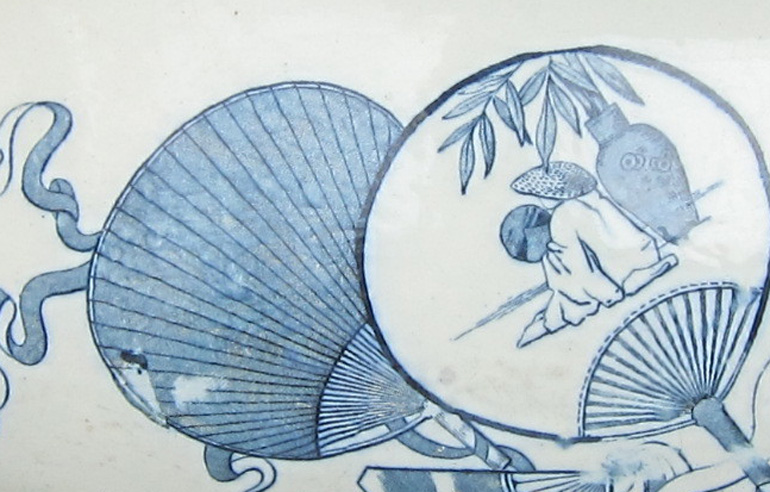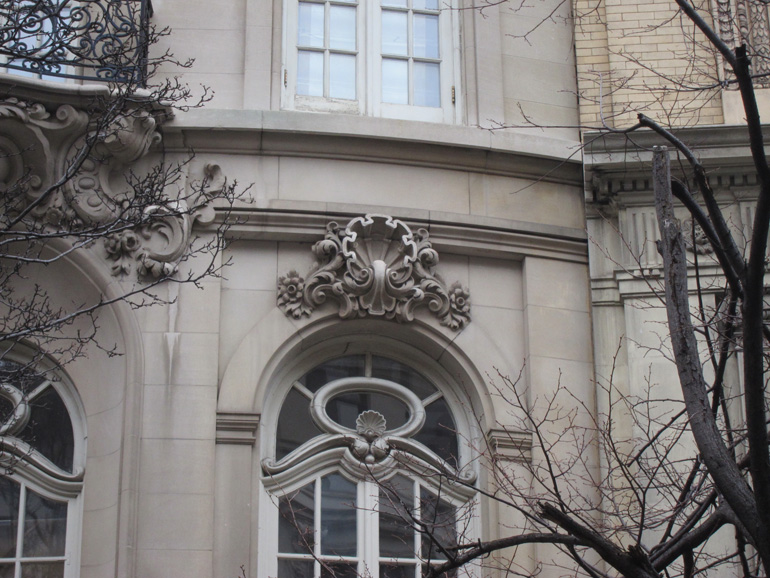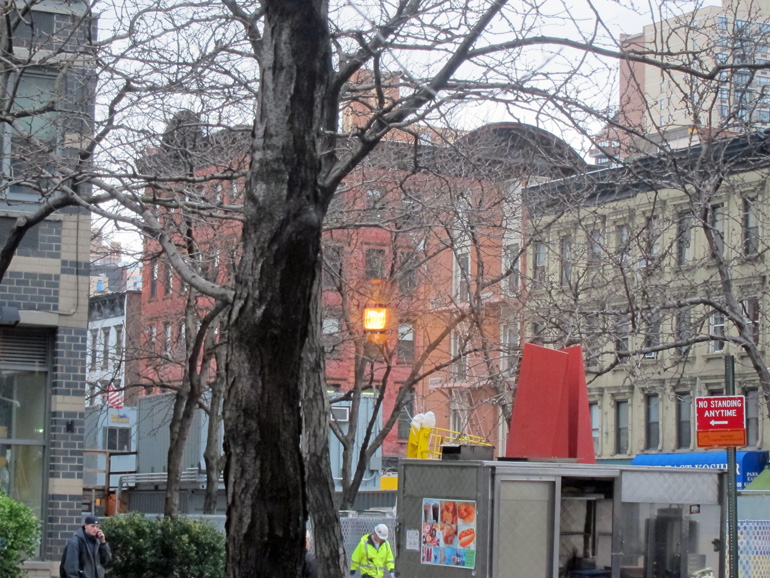
At Fairway, it was almost Sunday. My sole New Year’s resolution was not to go to Fairway on Sunday, and I’ve stickled on it. I forgot that today is a holiday — an honorary Sunday, so far as the madness at Fairway is concerned. I have lived in this neighborhood for more than thirty years, so I find myself asking, where do these crazy people come from? — these abstracted men and women who look like New Yorkers but who behave like suburbanites. Where is the charitable society that will protect us all from the miserable clutter of children in strollers? When will patrons look elsewhere for charming bazaars that are hospitable to companionate shopping? More than any emporium I’ve ever been in, Fairway is a military supply center. You go in, get what you need, and get out, as quickly and as painlessly as possible. If you’re lucky, the produce section is free of gridlock. If you’re lucky, the closing elevator door does not heave into reverse because some omedhaun couldn’t wait to press the button. If you’re lucky, there are no vacant middle-aged dingleberries holding someone else’s shopping basket in the middle of an aisle. You can count on not being lucky on Sunday.
And what is it with the management at Thomas’s? Why do they continue to turn out volume packages of the dinky original English muffins when it’s obvious that everyone wants the sandwich size, introduced about thirty years ago but still hard to get? Second New Year’s resolution: send a message. Never buy the small muffins just because the large ones (perfect for sandwiches) are unavailable. Spread the word that small ones are toxic, or were Hitler’s favorite, or anything you can think of to discourage purchases of the damned things.
***
I’ve been reading the most extraordinary book, which I hope regular readers will recognize as not my way of hailing a fave. What Art Is is the latest addition to Arthur Danto’s shelf of books about art. Danto is a philosopher in his late 80s who took up art criticism (notably for The Nation) in the early Eighties, and there’s something about him that I’ve always liked, even though I have no use for philosophy, and the current book completely mystifies me. In small part, I’m mystified because there are passages that I can’t quite parse. Writing up Descartes, Danto asks,
Can I be certain of anything whatever? The answer is yes. If I am always mistaken, I must at least be thinking that to be the case that is not.
This is infelicitous at best; it’s unwise, speaking English, to put so much weight on a term (“that”) that doubles as a relative pronoun. But I am largely mystified by the urge to philosophize. I don’t understand it at all. I understand why people do all sorts of things that I don’t want to do — drive race cars, bake clafoutis, balance stock portfolios, jump from planes; the list is endless, because there really aren’t that many things that I want to do. The world would be a very strange place if I couldn’t imagine other people’s interests — especially as one of the things that do like to do, read, presents such an endless range of activities. But with every year I understand philosophy less. I cannot understand the urge to press beyond what seems to be the case in search of what is the case, especially if, as the history of thought suggests, that search is bound to end in error. I should prefer to develop better ideas of what seems to be the case, and leave what is to God (including, of course, God, who certainly does not seem to be the case). The only sense that I can make of the urge to “do philosophy” is to see philosophy as an early version of Grand Theft Auto. A game, in short, with twists and turns that are very exciting to the adept, and that also calls for wellsprings of paranoia about what’s “really” going on.
Danto claims not to be an art historian, a truth embodied in nearly every page of his book, which continually uses the historical data of “art history” — he begins with the revolution wrought by Picasso’s Les Demoiselles d’Avignon and Duchamp’s Fountain — to unseat the rather obvious proposition that “art” is a profoundly Western concept, intimately tied to the contingencies of European history (Christianity in general and its power structures in particular) since, roughly, the Tenth Century; and to reject the corresponding notion that aesthetically charged objects from other cultures, especially those of East Asia, do not constitute the same kind of thing. Danto wants a definition of art that, with an abandon surprising in a philosopher, reeks of local historicity:
This book is intended mostly to contribute to the ontology of Art, capitalizing the term that it applies to widely — really to everything that members of art world deem worthy of being shown and studied in the great encyclopedic museums.
A stupefyingly provincial view! The ontology of art — the study of what art is, pointedly not the study of recognizing art when you see it (that’s epistemology, we’re told, or connoisseurship) — rests on the taste of the art-world elite, of the moment. In other words, what art is, is everything in the Metropolitan Museum of Art. Much as I adore that institution, my visits there have sharpened quite the opposite view. Most of what the Museum holds is not art, but it helps me to recognize the few things that are. But then, I am not a big-tent kind of guy. And I don’t begin to see the point of statements such as this: “Only that which belongs to all of art belongs to art as Art.”
***
In a gripping, if no less hard-to-follow discussion of the restoration of Michelangelo’s Sistine Ceiling (of which he disapproves), Danto focuses on the artist’s narrative plan for the nine “pictures” (which, fascinated by Andy Warhol’s Brillo Box, Danto presents as a doubling, as a single picture — the ceiling — of nine pictures — the narrative tableaux), and dwells on the last of the panels, which features the drunkenness of Noah, a Biblical event to which I hadn’t given much thought. Whatever I think of Danto’s philosophy, I am completely sold on his discussion of Michelangelo’s design, which in his view establishes the need for an incarnate saviour.
Possibly Noah, drunk and naked, implies the ineradicable weakness of human beings — after all, Noah, who was regarded as the one worth saving, is in the end a bad lot. Catastrophes, if there is to be any human remnant, are insufficiently radical solutions to the problem of human badness, and only the miracle of salvation is capable of overcoming the sins of our endowed substance. So the story that begins with creation ends with the need to intervene in history in a new way, by god himself taking on the attributes of the flesh and being reborn through suffering.
That’s the sort of thing that makes me pick up whatever Danto publishes. Genesis itself, however, suggests a different, if not incompatible, interpretation. Chapter 9 is taken up with God’s promise never to wreak another deluge; it is a second covenant with mankind (the first having been imposed on Adam). The last ten verses, in which Noah’s drunkenness is fleetingly mentioned, have a very tacked-on look to my eyes; I read them, and their curse of the Canaanites, as if I can see the Babylonian redactors slipping them into place here. (The Canaanites were cursed because Noah was pissed off that his son, Ham, dared to look at him when he was drunk and naked; the Canaanites descended from him. His brothers, Shem and Japhet, contrived to clothe their father with a cloth that they carried backwards, faces averted. It is the Bible at its most pruriently prudish. We’re at liberty imagine the real reasons for cursing the Canaanites.)
***
In today’s Metropolitan Diary, the Times published a report, by someone who lives in my neighborhood, about the funeral mass said at St Joseph’s Church, which I can see from my window, for a homeless man who used to camp out at the southeast corner of 87th and Second. I’m pretty sure that that’s who Lee Eisenberg is talking about; the homeless man who had a shopping cart and a dog and who nestled in a nook at the far end of the Food Emporium downstairs. Shorty, the dog, reportedly seated in the front pew at the funeral, has presumably acquired more comfortable digs since the death of Jose Perez. I always used to feel terribly sorry for the dog — what a boring life, tethered to a cart in a dark corner. I felt sorry for its owner, too, although I never gave him any money or in any way acknowledged him. I can understand running for office or driving a subway train or even writing for an advertising agency, but I can’t understand living in the street (even if only by day). My instinct is that it ought to be illegal; my urbanity counsels against butting in. Two hundred people attended Jose Perez’s funeral — to them, he was as much a part of the neighborhood as, say, the butchers at Schaller & Weber. (He seems to have been a personable man.) I am left in a tension: either my charity is limited, or charity — which Jose Perez never solicited — doesn’t come into it. Perhaps, if I were a philosopher, I would know what to think. But I’m not.




















